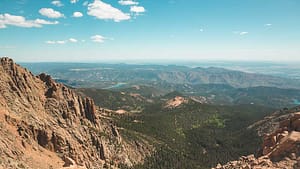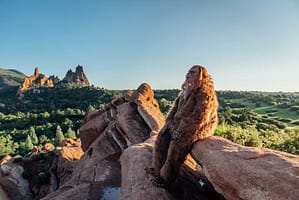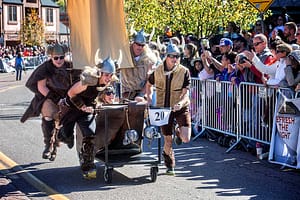How to Hike Pikes Peak in the Winter
What It Takes to Hike Pikes Peak
Let’s take a quick look at what it takes to hike Pikes Peak on a good day. Here are the basics. Barr Trail, the trail to the summit of Pikes Peak, is almost 13 miles long. That’s just shy of the length of a half-marathon. If you decide to hike back down (which we will address in a moment), you’ve just completed the equivalent of a full marathon. That’s a challenging hike even without the extra burden of winter.
As you ascend, you will gain 7,800 feet in elevation which is tough on even the most altitude-acclimated body. The air is thin, and you will have a more difficult time catching your breath the higher you climb. The last three miles to the summit will have you sucking wind if you don’t take your time and your body will be pretty bummed about the low oxygen in the air. You may find yourself taking frequent breaks.
The hike itself varies in technicality as you climb. Website AllTrails.com designates the trail as “hard,” and that rating is not based on winter hiking, which is much more difficult. On a good day, the average hiker can make it up in about 6-8 hours. In the summer, the experienced folks at Barr Camp, which marks the middle of the hike, recommend you get to Barr Camp as early in the day as possible and try get to the top and be back below the tree line by 1 p.m. What do they recommend in the winter? Nothing. There are no instructions for hiking Pikes Peak in the winter because it’s not a great plan.
Here's Why:
Limited Time to Get to the Summit
The days are shorter in the winter, narrowing your hiking window even if you are at the base at dawn to begin your journey. Hiking Pikes Peak in the dark is incredibly dangerous. Hiking any fourteener in the dark is dangerous.
- There are a variety of hazards if you make a wrong turn, like ravines, wild animals and loose rock beside dangerous drops.
- There is snow on the parts of the trail that don’t get sun, even when it’s a rather dry year. That snow will slow you down, especially if you don’t have proper footwear.
- The temps can take very steep drops after sundown.
- It’s also harder for search and rescue teams to find you in the dark.
Even if you make it to the top in time, you’ll may need a ride down if it’s getting late because you don’t want to force your tired body to pick its way down the mountain at high altitude in the dark (for all the reasons listed above and more). In the time it takes to hike up, you could also find that a storm has set in, making it impossible to head back down. That means you’ll have to pay for the train to take you back to the base of Pikes Peak or try to arrange a ride to meet you at the top—if you make it up before the summit closes. Keep in mind that the summit also closes earlier in winter. After hours will cost you as well and you may even have to resort to asking strangers for a ride. What you won’t want to do is try to go back down in the dark, especially if you didn’t pack a flashlight, cold weather gear or camping gear.
Now, you might say that you’re a great hiker and you can make it in time. That’s probably true. However, avid backpackers know that most outings will often have some sort of snafu that can slow them down considerably. You could be in peak shape (pun intended) and suddenly become ill, experience a shoe malfunction that slows travel, become injured, get lost on areas where the trail is less obvious or get altitude sickness.

The Weather is Even More Unpredictable in the Winter
Colorado mountain weather is wacky, to say the least. If you ever want to see how rapidly it can change just from altitude to altitude, take a drive up the Pikes Peak Highway and get out at the different scenic stops on your way to the summit. It may be a mild day at the base and snowing on the summit. The temperature drop during ascension can be drastic, requiring your body to also designate valuable energy to keeping you warm. Even in the summer, you can go from 90-degree weather to snow on the summit.
Let’s talk about that snow, because a blizzard is the last thing you want to encounter on a hike up Pikes Peak. A high elevation blizzard is a force of Colorado nature to be reckoned with (frankly, so are many of the low-elevation ones).
- The snowfall can be quite heavy, obscuring the trail and making it easy for any hiker get turned around or wander off the edge of one of the many drop-offs.
- The high winds only add to the dangers by dropping temperatures to new lows and completely destroying visibility with blowing snow. The wind also creates large drifts that will slow you down.
- If you left for the day thinking it would be an easy hike in the sunshine and have inadequate winter gear, you are in danger of frostbite, hypothermia and death.
- If you require a rescue to get you down, a storm will make you more difficult for search and rescue to find.
- Rescue requires you being able to get ahold of emergency services and cell service can be spotty on the mountain. There are also a lot fewer fellow hikers that might be able to help if you need it.
Safe Ways to Reach the Pikes Peak Summit in the Winter
If you just cannot go through an entire winter without summiting Pikes Peak, there are better ways to do so in the winter. They may not be as invigorating or challenging as a hike, but they will ensure you’re alive and well with all limbs and digits intact to make the ascent in the summer.
- Broadmoor Manitou and Pikes Peak Cog Railway: Take the train to the top of the summit and catch rare views of the mountain and all its beauty. It’s a fun ride with lots of info about its history you can file away for your summer attempt.
- The Pikes Peak Highway: Travel to the summit on your own time by driving yourself up the mountain. There are areas to stop and enjoy the views and scenery and the road is only open if it’s safely passable.
- The Pikes Peak Tour by Gray Line: This comfortable tour features information about the peak and scenic stops for photo ops. The bus has huge windows to ensure you never miss a view.
- You can learn more about these options here.
Reading this may have been a bit of a downer, but our only goal is to help you enjoy your time in Colorado safely. We hope that you’ll take our very well-intended advice seriously and wait until the warmer months to make your climb. If anything, it means you’ll have another reason to visit Colorado Springs.





